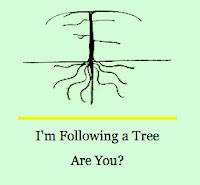In these dreary demoralizing times, I cling to the tiny-artists hypothesis. Autumn leaves are painted by darting leaf fairies so small that we can't see them, no matter how hard we try. But we can easily appreciate their masterpieces. Toward that end, I headed off to LaBonte Park to find out what the leaf fairies had done to my chokecherry tree.
This particular tree is my tree-following subject this year, the idea being to visit and report on it each month (I've missed a few). I was curious about the leaves because it's a purple-leaf chokecherry. What color do purple leaves turn in autumn?
LaBonte Park has a nice show of trees currently—yellow and orange deciduous trees, and dark green conifers.

On September 17, in the Mullen Creek drainage on the west side of the Medicine Bow Mountains, a spark still being investigated set the forest ablaze. These mountains are thick with standing dead trees, "victims" of pine bark beetles. In many areas, half to three-quarters of the trees are dead. With all this dry fuel and very strong winds, the Mullen Fire raced eastward, consuming 175,00 acres (71,000 hectares) as of this morning.

The purple-leaf chokecherries haven't changed much. The leaves are more on the red side of purple, but nothing dramatic.
Have you noticed the "subdued" quality of these photos? I resisted the temptation to photo-enhance. This is what our world looks like much of the time. Actually, this was a relatively good day.
 |
| LaBonte Park yesterday afternoon, "unhealthy for sensitive groups". |
 |
| St. Matthew's Cathedral in Laramie Oct. 5, "very unhealthy". Laramie Boomerang. |
 |
| Mullen Fire, just one of many in the western US (InciWeb, Oct. 11). |
 |
| Thirty miles south of the Mullen Fire, the Cameron Peak Fire is also burning beetle-killed trees and generating lots of smoke (InciWeb, October 11)). |
 |
| Smoke and airtanker, Mullen Fire. From every news outlet in the region; original source unknown. |
Next spring, it will be fascinating to investigate the mosaic of live and dead trees created by the fire ... perhaps a subject for 2021 tree following :)
For more news, visit our monthly gathering of tree-followers kindly hosted by The Squirrelbasket. Want to join in the fun? More here.







thank you for not enhancing the photos. There is a craze for that, but I am over it.
ReplyDeleteGood photos without the dialing up of colour is great.
Lovely photos of the leaves, I like the subdued pallette. The fires are scary,
ReplyDeleteOh dear, that's too bad. I didn't realize the fires were affecting Wyoming. One of our favorite vacations was camping in the Medicine Bow Mountains, so I'm somewhat familiar with that location. Sorry you have to breathe that air, too. Take care.
ReplyDelete